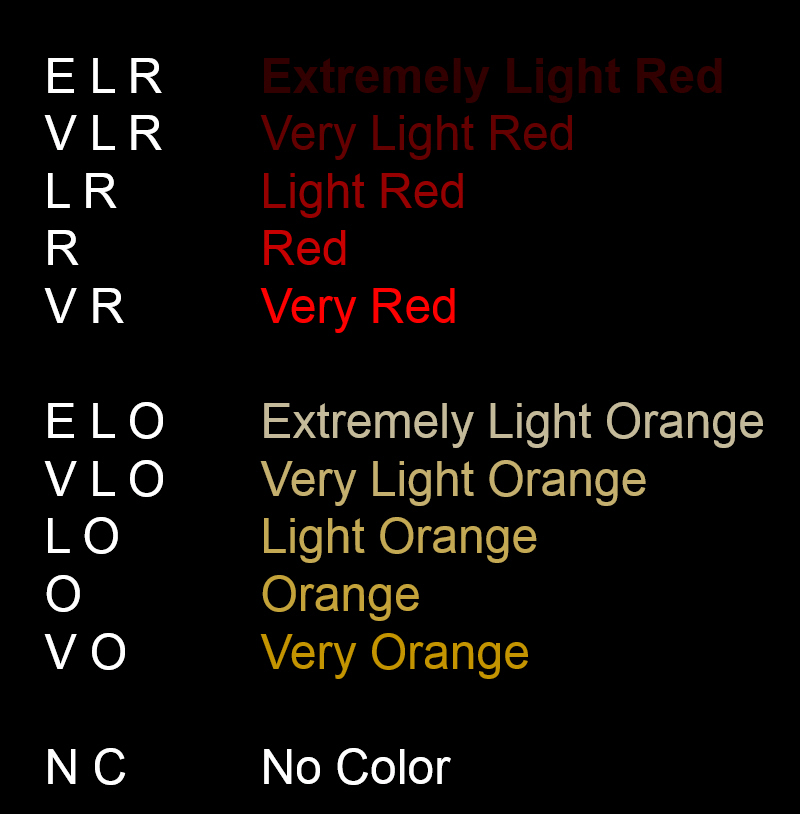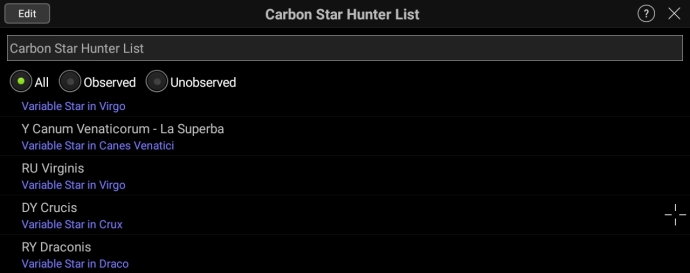Carbon Star Hunter List
By Luca Vanzella
It all started with RS Cyg in August 2009 when my observing buddy Jay Lavender and I were trying to find the Crescent Nebula. As I was sweeping the area near Sadr (Gamma Cyg), I suddenly noticed this very red star. Not orangy-red or salmony-pink, but red. A deep, kind of dull red, like the star was painted red, rather than shining red. Sky & Telescope’s Pocket Sky Atlas showed a star labelled “RS (c)” right where I was looking, so I thought “that label must mean it’s a Red Star, how appropriate”. Jay had a look with his 16″ Dobsonian and he also noted the redness although curiously it was less red in his scope than in my 8″ SCT.
I later learned the “RS” designation meant it was a variable star and that “(c)” in the Pocket Sky Atlas identified it as a carbon star. The coincidence of “RS” and “red star” got me curious about carbon stars and so an observing project was born. I decided to observe all 55 carbon stars labelled in the Pocket Sky Atlas. It was a relatively easy project since just about any size telescope could be used and although helpful, dark skies were not essential.
Since the Pocket Sky Atlas (PSA) does not include a list of carbon stars, I decided to make a list that could be taped onto a page of the atlas both for listing the best charts with which to find the carbon stars and to track my progress. Since the stars cover most of the hours in right ascension, I figured it would take a few months to a year to complete the list. Since the declinations vary from about +78 to about -39, I realized that some travel would be involved, since from my home in Edmonton AB (latitude 53.5), many of the carbon stars are not visible. Thanks to two fortuitous trips to southern locales, I was able able to complete the project in about 11 months.
Some time later, I came across other lists of carbon stars. Glenn LeDrew had written an article about carbon stars visible in the spring for the May/June 2010 issue of SkyNews magazine, that listed 10 carbon stars, all of which are plotted in the PSA. Jnani Cevvel alerted me to the Astronomical League’s Carbon Star Club (CSC)1 which has 100 stars. I noticed that CSC list does not completely overlap the PSA list. As I was working on combining these two lists, the RASC 2011 Observer’s Handbook (RASC) came out with a list of 123 carbon stars and again, there was no complete overlap with the PSA and CSC lists. I combined the PSA, CSC and RASC lists into a master list that included 142 unique carbon stars.
I also did some web searches for carbon stars, and found several lists (note that as of 2019 some of these links are broken).
The name Brian Skiff name came up several times on the web. He wrote a great article on carbon stars in the May 1998 issue of Sky & Telescope magazine. That article also had a list of carbon stars, including possibly the reddest carbon star of them all – DY Cru. Through conversation with Brian, I learned about star colors, B and V color indices, Tycho survey data anomalies, SIMBAD and VizieR.
After nearly drowning in data, I had come up with a list of 167 carbon stars. Jnani Cevvel’s comment about the list being the “mother of all carbon star lists” gave me pause. I wondered just how many I could see from North America and Hawaii, where I usually observe. I noted that I could bag 165 of them from these locations. I also asked myself what does this combined list of mine represent? What criteria am I using to include particular stars? I finally settled on color. The big thing about carbon stars for me is their redness. That’s mainly what I want to observe. Jnani likes estimating their magnitudes. I like describing their color.
Here is the personal color scale that I use when observing carbon stars:[2023-06-12 Update]
So I reconsidered my list. I decided to keep all 142 stars from the first three sources I found: PSA, CSC, and RASC. From the other sources, I decided that a B-V color index of 4.0 would be the cutoff, in keeping with the theme of redness. Brian Skiff’s article includes some very red carbon stars, 3 of which are not in the 142. The BL list includes 2 stars making the cutoff. The Sa1 list includes 1 star making the cutoff. This made a list of 142 + 3 + 2 + 1 = 148 stars. Since that was pretty close to a nice number of 150, I lowered the B-V cutoff to 3.8, which then added 2 more stars, one each from the BL and Sa1 lists, for a grand total of 150 stars. Thus was born the Carbon Star Hunter List.
As of 2012, I had logged 148 out of 150 stars. As of 2015, I had logged 146 out of 150! Why the drop? In 2015 the position, mag band and range, and spectral type of every star in the RASC Observer’s Handbook list had been adjusted – this included removing one star since it was not a carbon star (I had already observed it) and adding two stars (both of which were not on my list). I adjusted my list to match the RASC list and removed one star from the BL list. By the end of 2019, I had logged 147 out of 150 stars.
And so here it is, my Carbon Star Hunter list. It’s available in two formats:
Excel: Carbon Star Hunter List.xls
Sky Safari List: Carbon Star Hunter List.skylist
Note: The Sky Safari List file has a .TXT extension to enable downloading. Remove the .TXT extension before importing to Sky Safari.
I talked about this list on the:
The Actual Astronomy Podcast #333 – Carbon Stars with Luca Vanzella
_______________________________________________________
1 The CSC is now known as the Carbon Star Observing Program.
© 2019 Luca Vanzella.
